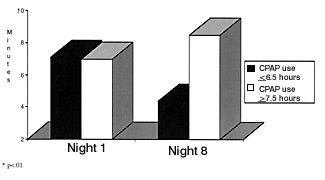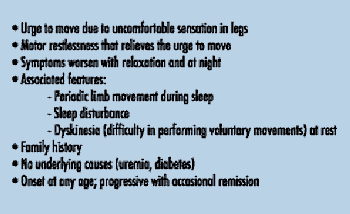CPAP mask retention of obese patients can be improved by affixing the mask to their teeth.
Patients may have great difficulty tolerating continuous positive airway pressure (CPAP) masks due to uncomfortable straps, air leaks, mask displacement caused by movement, or claustrophobia (often caused by the aforementioned problems). In many cases, these problems can be resolved by affixing the CPAP mask to the teeth of the upper jaw. As a result, the mask fits snugly but comfortably, without leakage and with reduced tension from mask straps. When attached in this way, the mask will stay in place, no matter how patients move their heads. Dentists who are familiar with plastics and appliances for the treatment of sleep disorders can be important sources of help with the resolution of CPAP mask problems.

Case Study
A morbidly obese female patient was referred by her pulmonologist at St Joseph’s Hospital in Toronto for her first consultation on April 6, 2004. She was 1.6 m tall and weighed 155 kg. She was 45 years old. Her breathing was labored and came in short bursts. Walking was a great effort for her, and she needed to use a cane. Her attitude was pleasant and cheerful, although she spoke slowly. She could tolerate standing only for a very short time; the need to stand for any length of time created severe back pain.
The patient complained of being tired and of inability to use her CPAP machine because the mask would never stay on properly. She went to sleep with the mask in position, but she habitually woke up during the night or in the morning with the mask either completely off or out of position on her head. When she awoke in the morning, she was always extremely tired and out of breath.
The patient was referred because of this extreme tiredness and her lack of success with CPAP therapy. Her lung specialist considered her main problems to be her weight, obstructive sleep apnea (OSA), and asthma. The patient had undergone polysomnography most recently on July 22, 2003. At that time, the sleep specialist reported that snoring was heard for 75% of the night, even when the patient was wearing nasal CPAP. At a pressure of 14 cm H2O, the snoring seemed to abate, but the patient was unable to tolerate this pressure level for any length of time. The patient had the best response at pressures of 12 and 13 cm H2O. The sleep specialist expressed doubt as to the patient’s compliance with her CPAP regimen at home. He also reported that the patient used a pressure of 14 cm H2O, but that the mask was off for most of the night. The specialist reported that, without a CPAP mask, this patient showed the worst OSA that he had ever seen.
The sleep specialist was doubtful of any need to repeat the study unless some other means of administration of therapy would be used (such as a chin strap, bilevel PAP, or a full-face mask). The specialist stated that the patient’s underlying apnea had worsened since her last assessment and that this might be purely due to aging. Her weight seemed to be stable during the intervening time.
The current study from July 22, 2003, showed that 16% of the night was spent in stage 1 sleep, 68% in stage 2 sleep, 1.3% in slow-wave sleep, and 13.7% in rapid–eye-movement (REM) sleep. Sleep efficiency was 71.4% and there were no periodic limb movements; 29 minutes were spent supine and 283.3 minutes were not. There were no central apneas, but there were 157 obstructive apneas. There were no mixed apneas, but there were 608 hypopneas. The apnea-hypopnea index was 171.7; oximetry results showed that 30.7% of the night was spent in the 90% to 100% oxygen-saturation range; 80% to 90% saturation was present for 45% of the night, and 20.2% of the night was spent at less than 80% saturation.

Treatment
The patient was referred to the dental office because CPAP therapy was not working and as a last resort the pulmonologist believed that an oral appliance might give the patient some relief.
Upon examining the patient, taking her history, and reading the polysomnography reports, I felt that an oral appliance alone was unlikely to relieve OSA of this unusual severity, and could actually put the patient at more risk. This was because she had poor manual dexterity and struggled with placing an oral device. It took a great deal of time and effort to help her place the oral appliance, as it made her tired and emotionally upset. Placing the maxillary part of the oral appliance was much easier for her. I have used oral appliances alone for many patients with very severe apnea, with very respectable results1,2; however, in this case, I would not attempt it.3,4 I believed that the best treatment would be to adjust the CPAP mask until it reached a stable, immovable form. It would be held in position no matter how the patient moved her head, and it would not be removable unless she was conscious. She could not remove it while she slept.
Methods
An extension arm fits onto the front of the maxillary arch of a popular adjustable mandibular advancement dental appliance used to treat OSA. This arm has a vertical attachment that can be tightened against any standard CPAP face mask. The arm is attached to the mask while the patient is wearing it with the upper part of the dental appliance, so that the mask and the appliance’s upper half are one solid unit. In this case, I fabricated an appliance for the patient. Using only the upper part, I attached the appliance to the mask using screws and ThermAcryl™ thermoplastic material to reinforce and strengthen the joint of the mask to the dental appliance. While the patient found placing the maxillary portion easy, trying to seat the whole appliance was too much of a struggle for her, especially when combining it with a mask. If she could have used the two together, her pressure setting could probably have been dramatically reduced.
Results
The pulmonologist reports that the patient is better, sleeps well without snoring, and uses the dental appliance to keep her CPAP mask in place. Her weight is unchanged, her heart rate is 90 beats per minute, her Pco2 is 45 mm Hg, and her oxygen saturation is 92%.
The pulmonologist recommended exercise (which includes walking for 6 minutes 20 times per day) and a weight-loss program. The patient was then referred to a bariatrician.
Discussion
Affixing the CPAP mask to the teeth is an excellent method of retaining the CPAP mask in position. The attachment to the teeth must be comfortable and the mask must be held close to the face, which prevents leaking. Fastening the straps of the mask, tightening the oral appliance in place, and fitting the appliance on the teeth must be performed carefully and checked with the patient to ensure comfort. Ease of use and patient compliance with CPAP therapy will improve as a result.
Jeffrey Paul Pancer, DDS, practices dentistry in Toronto, sits on the board of the Academy of Dental Sleep Medicine, and chairs its Standards and Practice Committee.
References
1. Pancer J, Al-Faifi S, Al-Faifi M, Hoffstein V. Evaluation of variable mandibular advancement appliance for treatment of snoring and sleep apnea. Chest. 1999;116:1511-1518.
2. Thornton WK, Roberts DH. Nonsurgical management of the obstructive sleep apnea patient. J Oral Maxillofac Surg. 1996;54:1103-1108.
3. American Sleep Disorders Association, Standards of Practice Committee. Practice parameters for the treatment of snoring and obstructive sleep apnea with oral appliances. Sleep. 1995;18:511-513.
4. Schmidt-Nowara WW, Lowe A, Wiegand L, et al. Oral appliances for the treatment of snoring and obstructive sleep apnea: a review. Sleep. 1995;18:501-510.




